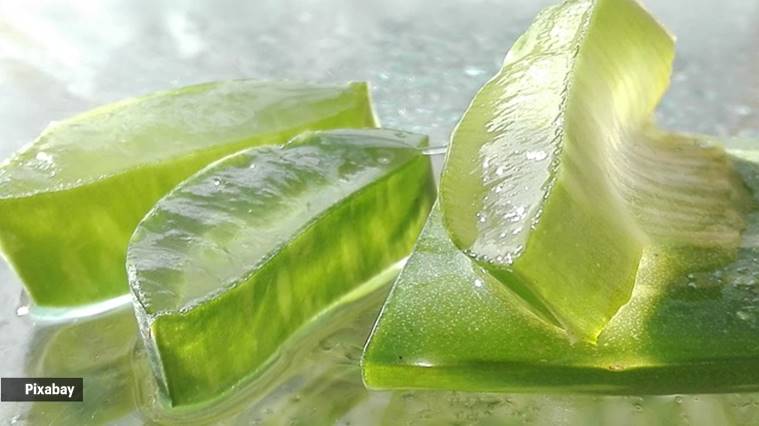📣 For more lifestyle news, click here to join our WhatsApp Channel and also follow us on Instagram
Let’s find out if experts recommend the viral DIY aloe vera ice facial
Aloe vera is commonly used to treat sunburns, acne, and other skin conditions.
 Aloe vera has numerous benefits for your skin. (Pic source: Getty/Thinkstock)
Aloe vera has numerous benefits for your skin. (Pic source: Getty/Thinkstock)Owing to its anti-inflammatory, moisturising, and soothing properties, aloe vera is known for its multiple benefits for the skin. As such, you would have seen many people directly scooping out the pulp from the plant and applying it on their faces to reap the benefits of its amazing properties. Actor Roshni Chopra, too, seems to be a believer in the wonderous benefits of this cactus-like plant as she took to Instagram to share that the viral aloe vera ice facial — which can easily be done at home — actually works for her. She claimed that it helps “to smoothen, hydrate and brighten” her dry skin.
“It actually WORKS!! Aloe is known for its vitamin, mineral-rich constitution and has anti-inflammatory properties too — it instantly hydrates and brightens my face, and in iced form makes my pores appear much smaller,” she wrote.
Revealing how to prepare aloe vera ice, she wrote, “Use fresh aloe plant leaf (you can also use aloe gel) and just scrape out the gel from inside the leaf and freeze for 5-6 hours in any mould”, adding that, “even ice cubes would work as the face doesn’t need that much. Apply the rest on your hair as a mask and wash off after 10 minutes to see the glow.”
View this post on Instagram
Speaking with indianexpress.com, Dr Swapna Priya Consultant – Dermatology, CARE Hospitals, Banjara Hills, Hyderabad shared that aloe vera indeed has various benefits for the skin. “It contains vitamins, minerals, and antioxidants that help to soothe and heal the skin. It is commonly used to treat sunburns, acne, and other skin conditions. Aloe vera also helps to moisturise and hydrate the skin, reducing the appearance of fine lines and wrinkles”.
Concurring, Dr Anagha Samarth, Consultant Dermatologist and Dermatosurgeon , SPARSH Hospital added that aloe vera contains vitamin A, C, E — the main vitamins involved in the functioning of antioxidants, which is very important for our body.
“Any form of antioxidant is important to flush out the free radicals. In addition to this, it also contains vitamin B 12 and folic acid, which helps in normal functioning of skin, hair, and nails. In addition, aloe vera contains anti-inflammatory enzymes, minerals, and fatty acids, all of which have an anti-inflammatory effect. They also contain hormones like auxins that have healing as well as anti-inflammatory properties. These ingredients have anti bacterial, anti septic and cleansing properties. It has both a holistic approach and benefits on the skin,” she added.
 Aloe vera contains vitamin A, C, E, which are involved in the functioning of antioxidants. (Pic: Pixabay)
Aloe vera contains vitamin A, C, E, which are involved in the functioning of antioxidants. (Pic: Pixabay)
Is DIY skincare recommended?
Despite aloe vera’s numerous benefits for the skin, doctor’s are wary of recommending DIY treatments. “The effectiveness of aloe vera DIYs depends on the specific recipe and the individual’s skin type and needs. Since, aloe vera has been shown to have many benefits for the skin, so incorporating it into a DIY skincare routine can be beneficial. But it is important to use high-quality, pure aloe vera gel and to patch test any new DIY recipe before applying it to the entire face,” shared Dr Priya.
She added that aloe vera should not be applied to open wounds or cuts as it can cause irritation. “Additionally, individuals with allergies to garlic, onions, or tulips may also be allergic to aloe vera,” she shared.
Calling DIYs a “double-edged sword,” Dr Samarth said that aloe vera can cause redness, burning, stinging and allergic reactions. “Before using, it should be tested in a small concentration. Also, it should not be used for a large area, especially on the face, in the first instance. You can probably do a test patch on the rest of the body, preferably your hands or legs and if it is not causing any problems for 2-3 days after using it continuously, you can then go ahead and try it on the face.” he concluded.
📣 For more lifestyle news, follow us on Instagram | Twitter | Facebook and don’t miss out on the latest updates!
📣 For more lifestyle news, click here to join our WhatsApp Channel and also follow us on Instagram






- 01
- 02
- 03
- 04
- 05





















